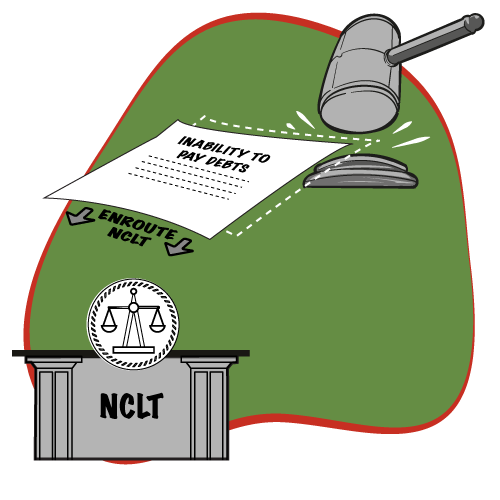Winding Up: The Journey from HC to NCLT

In recent times
In November 2020, the Supreme Court passed a judgment stating that ANY creditor of a company in liquidation can become a party to winding up of a company and seek transfer of the winding up petition from a High Court (HC) to the National Company Law Tribunal (NCLT). A landmark judgment that reiterates that all creditors are equal when it comes to exercising their rights / powers in the winding up process / insolvency.
In this context, we bring an insight into the case M/s. Kaledonia Jute and Fibres Pvt. Ltd. Vs. M/s. Axis Nirman and Industries Ltd. & Ors. [Civil Appeal No. 3735 of 2020 arising out of S.L.P. (Civil) No. 5452 of 2020]
Facts of the case
- M/s Girdhar Trading Co, (“Girdhar Trading”) the 2nd respondent filed a petition before the Allahabad HC for winding up of 1st respondent (“Axis Nirman”) under section 433 of the Companies Act, 1956 on ground of inability to pay debts.
- The (erstwhile) company court order notice to Axis Nirman but it failed to appear before the Company Court. Hence the Company Court ordered admission of the winding up petition and ordered the publication of advertisement of the petition in accordance with the company winding up rules. Accordingly Girdhar Trading effected a publication of advertisement and published the date of hearing of the company petition.
- On the said date of hearing, the company court passed an order directing the windin up of Axis Nirman on grounds of inability to pay debts and that it was just and equitable to do so.
- Accordingly, an Official liquidator (OL) attached to the Allahabad HC was appointed to take over the assets and books of accounts of the company. The court also directed the order of winding up to be published as per requirement of the law.
- Thereafter Axis Nirman filed an application for recalling the winding up order. They they paid the entire dues to Girdhar Trading along with costs and hence wanted the recalling of the winding up order. Girdhar Trading had no objection to such recall of the order.
- But the Official liquidator opposed the recall on the grounds that Axis Nirman owed money to the tune of Rs. 27 crores to various other creditors. Unless all the mount was paid / made good, winding up order could be recalled. The OL had further stated that he had already taken charge of the assets of Axis Nirman.
- Based on this, the company court passed an order keeping the winding up order in abeyance. However, the court directed the OL to continue to keep custody of the assets.
- In the meantime the appellant in this case M/s. Kaledonia Jute and Fibres Pvt. Ltd (“Kaledonia”) claiming to be a creditor of Axis Nirman moved an application before NCLT bench of Allahabad u/s 7 of the IBC, 2016. Kaledonia claimed that Axis Nirman failed to pay its outstanding dues to the extent of Rs. 32 lakhs despite repeated demands.
- Thereafter Kaledonia moved an application vide a civil miscellaneous application before the Company Court (High Court) seeking the transfer of winding up petition to NCLT, Allahabad. This application was rejected by the Company Court (HC) on the grounds that winding up order had already been passed. Hence the transfer of winding up petition from HC to NCLT was refused.
- Hence Kaledonia has come up with this civil appeal in the Supreme Court challenging such refusal.
Issues for consideration
The 3 Judge bench of the Hon’ble Supreme Court comprising Chief Justice of India S.A Bobde, Justice A.S Bopanna and Justice V. Ramasubramanian had to consider the following:
- What are the circumstances under which a winding up proceeding pending on the file of a High court could be transferred to the NCLT and
- At whose instance, such transfer could be ordered.
The Analysis
The Hon’ble Supreme Court delved into sections 434 and Rules relating to winding up under the Companies Act and the Rules. On analysis of the section and rules, the Apex Court was of the view that:
- Section 434 of the Act and clause (b) of Section 434 are entirely different. Section 434 deals with transfer of proceedings pending either before CLB or Company Court, while Section 434(b) deals with right to appeal to the HC against any decision of the CLB. Clause (b) is a misfit in Section 434.
- Section 434(1)(c) provides for transfer of all proceedings under the Companies Act, 1956 pending before any District Court or High Court to the NCLT. Due to the usage of words “All proceedings …..” clause (C) has wider application.
- The first proviso to Clause (c) restricts the transferability of proceedings for winding up from the High Court to the tribunal, by stipulating that only such proceedings for winding up which are at a stage as may be prescribed by the Central Government, be transferred to the Tribunal.
- Section 434 (2) empowers the Central Government to make Rules consistent with the provisions of the Act, to ensure timely transfer of all matters pending before the Company Law Board or the Courts, to the Tribunal.
- For the purpose of transfer of proceedings, section 434 is divided into two categories (a)Proceedings for voluntary winding up where notice of resolution by advertisement has been given under Section 485(1) of the Companies Act, 1956, but the company has not been dissolved before 01.04.2017; and (b) Other types of winding up proceedings.
- Cases of voluntary winding up of a company where notice of the resolution by advertisement has been given under the relevant rule but the company has not been dissolved before the 1st April 2017 shall continue to be dealt with in accordance with provisions of the Companies Act, 1956 and the Companies (Court) Rules, 1959.
- It is only (i) cases of voluntary winding up falling outside the scope of the 4th Proviso as stated above and (ii) other types of winding up proceedings, which can be transferred by the High Courts to the Tribunal, subject however to the Rules made by the Central Government under Section 434 (2).
- The transferability of winding up proceedings, other than those covered by the 4th Proviso as stated above, depends upon the stage at which they are pending before the Company Court. This is left to the discretion of law makers to be determined in the form of Rules.
- Section 434 (1)(c) also gives a choice to the parties to those proceedings to seek a transfer of such proceedings to the NCLT under the fifth proviso to Clause (c).
- A detailed analysis of the Companies (Transfer of Pending Proceedings) Rule, 2016 categorise the pending proceedings for winding up into three types:
(i) proceedings for voluntary winding up covered by the Section 434(1) (C) 4th proviso which shall continue to be dealt with in accordance with the provisions of the 1956 Act;
(ii) proceedings for winding up on the ground of inability to pay debts; (Rule 5) and
(iii) proceedings for winding up on grounds other than inability to pay debts. (Rule 6) - Rule 5 provides for transfer of proceedings for winding up on the ground of inability to pay debts. The Rule states that All petitions relating to winding up of a company under on the ground of inability to pay its debts pending before a High Court, and, where the petition has not been served on the respondent under Rule 26 of the Companies (Court) Rules, 1959 shall be transferred to a duly constitute Bench of the Tribunal (NCLT). This is subject to all information being submitted up to 15th July 2017. Thereafter, fresh applications shall be filed us/ 7or 8 or 9 of the IBC 2016.
- Rules 5 and 6 of the Companies (Transfer of Pending Proceedings) Rules 2016, fix the stage of service of notice under Rule 26 of the Companies (Court) Rules, 1959. The stage at which a winding up proceeding can be transferred.
- Vide judgment in Forech India Ltd. vs. Edelweiss Assets Reconstruction Co. Ltd, it was held that that “Rules 26 and 27 clearly refer to a preadmission scenario.” If the winding up petition has already been served on the respondent in terms of Rule 26 of the 1959 Rules, the proceedings are not liable to be transferred. But if service of the winding up petition on the respondent in terms of Rule 26 had not been completed, such winding up proceedings, whether they are under Section 433 Clauses (a) or (c) or (f) shall peremptorily be transferred to the NCLT.
- The Court pointed out in Forech India Ltd. (supra) that “when the Code was enacted, only winding up petitions where no notice under Rule 26 was served, were to be transferred to NCLT and treated as petitions under the Code”. However, after Section 434 was substituted by a new provision under in 2018 by insertion of 5th proviso the transfer of the winding up proceedings, even at the instance of the party or parties to the proceedings became permissible.
- While noting the change of position after the insertion of 5th proviso in 2018, Court observed “any person could apply for transfer of such petitions to the NCLT under the Code”. It is interpreted that “party” or “parties” (and not necessarily a party to the proceeding) could apply for transfer. Thus the proceedings for winding up of a company are actually proceedings in rem to which the entire body of creditors is a party. Though the proceeding may have been initiated by one or more creditors, ALL creditors are entitled to be treated “parties”.
- The Apex Court further noted that the restriction under Rules 5 and 6 of the Companies (Transfer of Pending Proceedings) Rules, 2016 relating to the stage at which a transfer could be ordered, has no application to the case of a transfer covered by the 5th proviso to Section 343 (1) ( c). Therefore, the impugned order of the High court rejecting the petition for transfer on the basis of Rule 26 of the Companies (Court) Rules, 1959 is flawed.
The Judgment
Based on the Section, analysis and precedents, the Hon’ble Supreme Court set aside the petition refusing petition seeking transfer of winding up petition from HC to the NCLT. Accordingly, the appeal was allowed.
The Judgment by the three Judge bench of the Hon’ble Supreme Court has reiterated the rights of the creditors once again and endeavoured to secure their interests.
For text of the Judgment:
https://main.sci.gov.in/supremecourt/2020/8017/8017_2020_31_1501_24702_Judgement_19-Nov-2020.pdf

